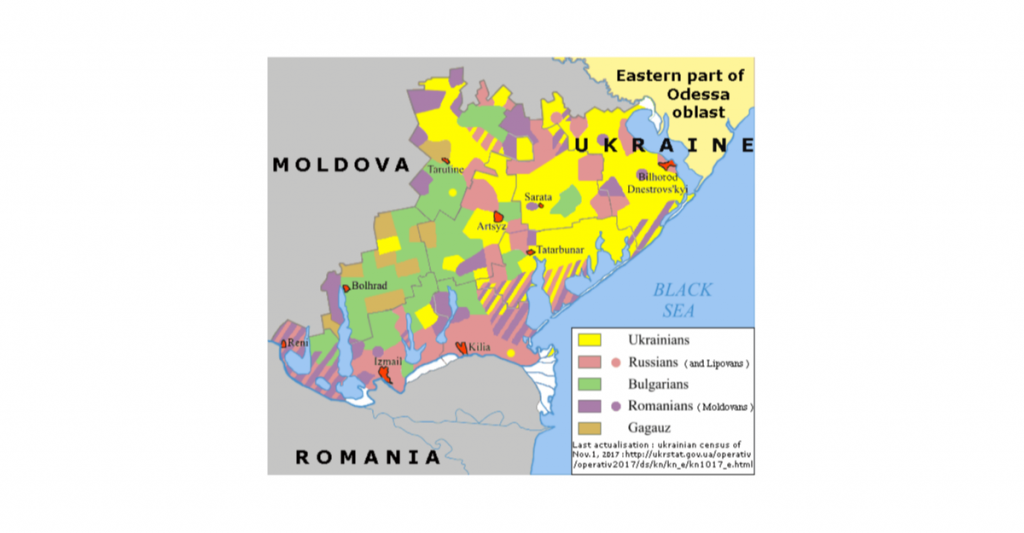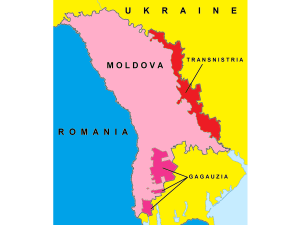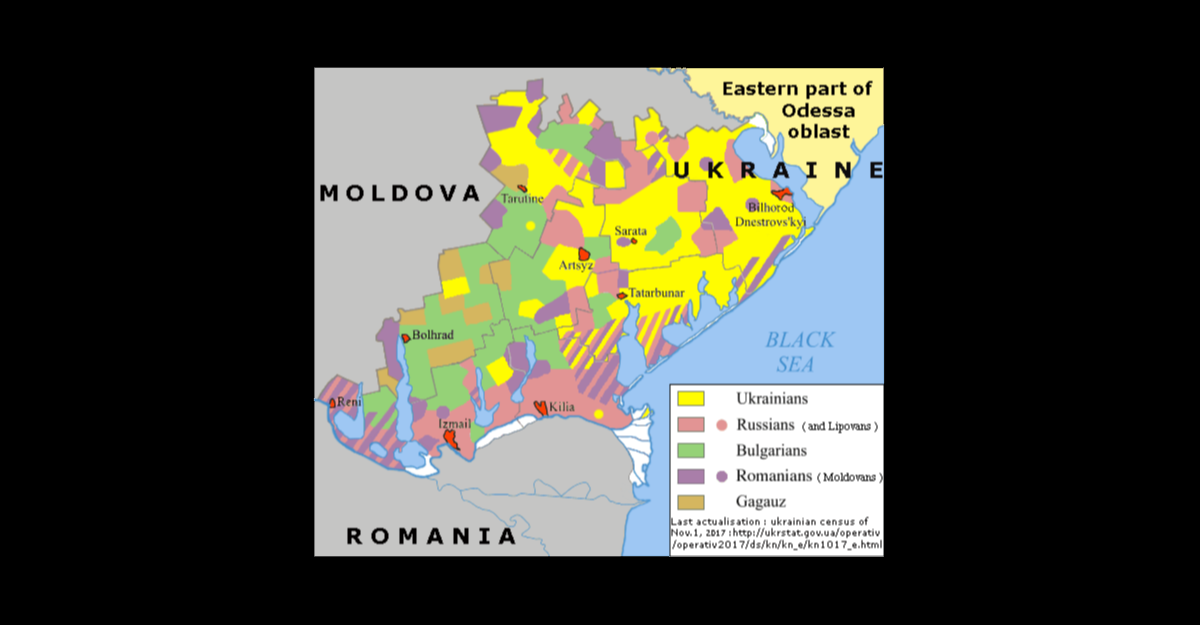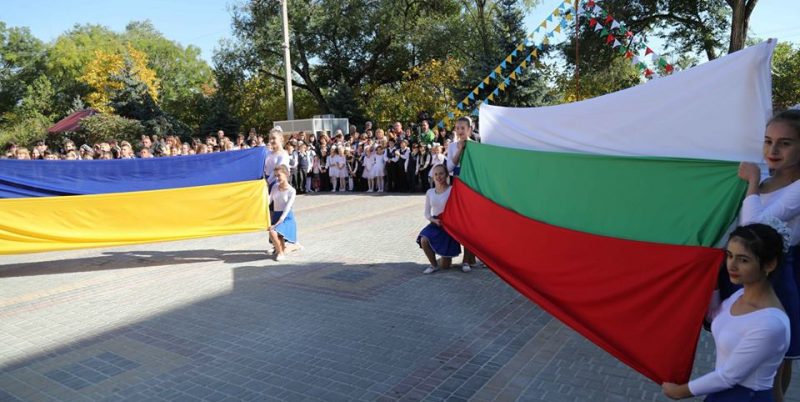The Odesa oblast (province), including its western (“Bessarabian”) part as well as Transnistria, had been a focus of discussions about “Novorossiya” in Russian nationalist circles, before the Kremlin took charge of this project in 2014 at the latest. The city of Odesa almost fell to Novorossiya supporters in May 2014. At about that time, Moscow switched the project’s focus to Donetsk and Luhansk, although (ironically) these were not considered parts of historic Novorossyia.
The “Bessarabian” part of the Odesa province has been described as an “ethnographic Harlequin [crazy quilt],” comprised of juxtaposed and interspersed nationalities. All of them are numerical minorities; and while ethnic-Russians are one minority among the others, Russian is the lingua franca de facto in this region as a legacy of Russian imperial and Soviet policies.
Adding to this area’s potential vulnerabilities, it suffers from insufficient and decrepit rail and road connections with the rest of Ukraine. The impact of Ukrainian mass media, and of Ukrainian cultural life generally, remains low.
According to Ukraine’s latest census, 621,000 people resided in the Bessarabian part of the Odesa province as of 2001. The census reported 40 percent Ukrainians, 21 percent Bulgarians, 20 percent Russians, 13 percent Moldovans, 4 percent Gagauz, and some smaller groups in that population. The ethnic breakdown, however, does not coincide with the language breakdown in the population, owing to the historic legacy of linguistic Russification of the non-Russians. Fully one half of the ethnic Ukrainians and about the same proportion of ethnic Bulgarians declare Russian as their native language and/or their language of first use. Russian remains the dominant language in local media and all spheres of public life (State Statistics Committee of Ukraine, 2001 census, accessed May 27, 2020).

Ethnic Bulgarians number 140,000 in the Bessarabian part of the Odesa province under the same census. Bulgarians form the majority in the Bolhrad district (“raion”), at 61 percent (followed by the Gagauz, at 19 percent). Bulgarians form pluralities in the Artsiz district, at 39 percent (followed by Ukrainians at 27 percent), and in the Tarutino district, at 37.5 percent (followed by Ukrainians at 24.5 percent). Smaller Bulgarian communities reside also in nearby districts (Soviet-style raions). None of these hold any kind of special status; and they are scheduled to be replaced by smaller, self-governing “hromadas” (communities) of amalgamated villages (see accompanying article).
Following the Novorossiya undertaking’s failure, Moscow came up with two projects in 2015, closely tailored to this part of the Odesa province: the “Bessarabian People’s Rada [Council]” and the “Bessarabian People’s Republic.” These envisaged a “national-cultural” special status as well as a political special status for this territory, with the intent of detaching it from Ukraine. These projects met with some support from openly Russophile political groups in Bulgaria and Moldova, such as Volen Sidorov’s Ataka Party in Sofia and the ethnic-Bulgarian former prime minister of Moldova, Vasile Tarlev, the head of the “Russia’s Friends in Moldova” association. Those two projects failed for a number of reasons, not the least of which being the implicit challenge to local ethnic community leaders, status quo–oriented power brokers intent on preserving their positions (see EDM, April 9, 13, 2015).
Trending Now

The Ukrainian-Moldovan border bisects southern Bessarabia and, with that, divides Ukraine’s Bulgarian community from Moldova’s. Along that border, Moldova has a special-status unit in the Gagauz autonomy and a potential aspirant to special status in the Bulgarian-majority Taraclia district (raion). A proposal to institute a “national-cultural special status” for Taraclia is currently pending in the Moldovan parliament, submitted by two deputies from President Igor Dodon’s Socialist Party (Deschide.md, March 5, 2020).

This proposal seems designed at least in part to lock in Taraclia’s ethnic-Bulgarian votes for the Socialists in the upcoming presidential and parliamentary elections. It does, however, have an antecedent from 2015, when the Communist Party and then-ruler Vladimir Plahotniuc’s Democratic Party proposed a special national-cultural status for Taraclia and had it adopted by the parliament in the first reading (see EDM, April 13, 14, July 2, 2015).
Any forward movement with the currently pending parliamentary bill would serve pro-Russia circles and Moscow. It would enable them to cite a Moldovan precedent in support of new calls for special status in Moldova and across the border in Ukraine’s Odesa province.
Read More:
- Bulgaria takes issue with Ukraine over minority in Odesa province
- Moscow orchestrates controversy between Bulgaria and Ukraine to weaken Kyiv
- Revision of History: How Russian historical propaganda justifies occupation of entire south-eastern Ukraine
- Will Russian provocations succeed in Odesa?
- The Odesa tragedy: bloody trail of the “Russian spring” – new film by human rights group
- Russian Propaganda Pushes Fake “Republic of Budjak”
- Ukrainian hackers publish Surkov’s plans to destabilize Ukraine in coming months
- The Kremlin’s other separatist projects in Ukraine





